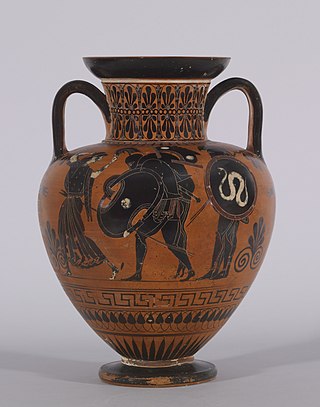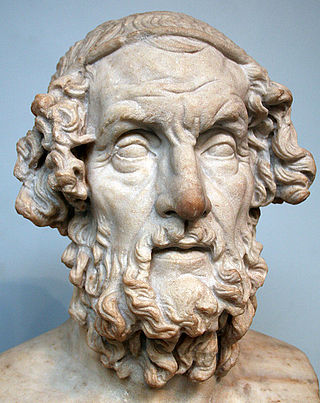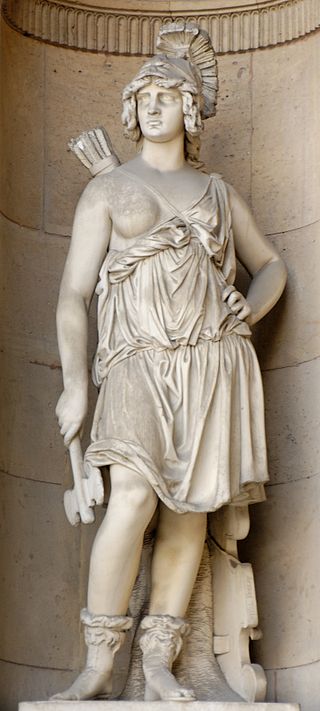
Ajax or Aias is a Greek mythological hero, the son of King Telamon and Periboea, and the half-brother of Teucer. He plays an important role in the Trojan War, and is portrayed as a towering figure and a warrior of great courage in Homer's Iliad and in the Epic Cycle, a series of epic poems about the Trojan War, being second only to Achilles among Greek heroes of the war. He is also referred to as "Telamonian Ajax", "Greater Ajax", or "Ajax the Great", which distinguishes him from Ajax, son of Oileus, also known as Ajax the Lesser.
Dactylic hexameter is a form of meter or rhythmic scheme frequently used in Ancient Greek and Latin poetry. The scheme of the hexameter is usually as follows :

Homer was an Ancient Greek poet who is credited as the author of the Iliad and the Odyssey, two epic poems that are foundational works of ancient Greek literature. Homer is considered one of the most revered and influential authors in history.

Archilochus was a Greek lyric poet of the Archaic period from the island of Paros. He is celebrated for his versatile and innovative use of poetic meters, and is the earliest known Greek author to compose almost entirely on the theme of his own emotions and experiences.

Penthesilea was an Amazonian queen in Greek mythology, the daughter of Ares and Otrera and the sister of Hippolyta, Antiope, and Melanippe. She assisted Troy in the Trojan War, during which she was killed by Achilles or Neoptolemus. The asteroid 271 Penthesilea, discovered in 1887, was named in her honor.

Diomedes or Diomede is a hero in Greek mythology, known for his participation in the Trojan War.

The Epic Cycle was a collection of Ancient Greek epic poems, composed in dactylic hexameter and related to the story of the Trojan War, including the Cypria, the Aethiopis, the so-called Little Iliad, the Iliupersis, the Nostoi, and the Telegony. Scholars sometimes include the two Homeric epics, the Iliad and the Odyssey, among the poems of the Epic Cycle, but the term is more often used to specify the non-Homeric poems as distinct from the Homeric ones.

The Aithiopis, also spelled Aethiopis, is a lost epic of ancient Greek literature. It was one of the Epic Cycle, which told the entire history of the Trojan War in epic verse. The story of the Aethiopis lands chronologically after the Homeric Iliad, and could be followed by that of the Little Iliad. The Aethiopis was often attributed by ancient writers to Arctinus of Miletus who lived in the 8th century BC. The poem comprised five books of verse in dactylic hexameter. Very few fragments of the Aethiopis survive today; Proclus's summary of the poems' contents establishes the narrative framework of the epic.
The Little Iliad is a lost epic of ancient Greek literature. It was one of the Epic Cycle, that is, the Trojan cycle, which told the entire history of the Trojan War in epic verse. The story of the Little Iliad comes chronologically after that of the Aethiopis, and is followed by that of the Iliou persis. The Little Iliad was variously attributed by ancient writers to Lesches of Pyrrha, Cinaethon of Sparta, Diodorus of Erythrae, Thestorides of Phocaea, or Homer himself. The poem comprised four books of verse in dactylic hexameter, the heroic meter.

The Iliupersis, also known as The Sack of Troy, is a lost epic of ancient Greek literature. It was one of the Epic Cycle, that is, the Trojan cycle, which told the entire history of the Trojan War in epic verse. The story of the Iliou persis comes chronologically after that of the Little Iliad, and is followed by the Nostoi ("Returns"). The Iliou persis was sometimes attributed by ancient writers to Arctinus of Miletus who lived in the E. The poem comprised two books of verse in dactylic hexameter.
The Cypria is a lost epic poem of ancient Greek literature, which has been attributed to Stasinus and was quite well known in classical antiquity and fixed in a received text, but which subsequently was lost to view. It was part of the Epic Cycle, which told the entire history of the Trojan War in epic hexameter verse. The story of the Cypria comes chronologically at the beginning of the Epic Cycle, and is followed by that of the Iliad; the composition of the two was apparently in the reverse order. The poem comprised eleven books of verse in epic dactylic hexameters.

Nikolay Ivanovich Gnedich was a Ukrainian-born Russian poet and translator best known for his translation of the Iliad (1807–29), which is still the standard one. He also wrote Don Corrado de Gerrera (1803), which has been called the first Russian Gothic novel.

The Greek word aoidos referred to a classical Greek singer. In modern Homeric scholarship aoidos is used by some as the technical term for a skilled oral epic poet in the tradition to which the Iliad and Odyssey are believed to belong.

Ancient accounts of Homer include numerous passages in which archaic and classical Greek poets and prose authors mention or allude to Homer. In addition, they include the ten biographies of Homer, often referred to as the Lives.

The Archaeological Museum of Corfu in Corfu, Greece was built between 1962 and 1965. The museum land was donated by the city of Corfu. Its initial purpose was to house the archaeological finds from the Temple of Artemis in Corfu. In 1994 it was expanded with the addition of two more exhibit halls that display the more recent finds at the ancient citadel of Corfu. It is located on 1 Vraila Armeni St.

Oral-formulaic composition is a theory that originated in the scholarly study of epic poetry and developed in the second quarter of the twentieth century. It seeks to explain two related issues:
- the process by which oral poets improvise poetry
- the reasons for orally improvised poetry having the characteristics that it does

The Iliad is one of two major ancient Greek epic poems attributed to Homer. It is one of the oldest extant works of literature still widely read by modern audiences. As with the Odyssey, the poem is divided into 24 books and was written in dactylic hexameter. It contains 15,693 lines in its most widely accepted version. Set towards the end of the Trojan War, a ten-year siege of the city of Troy by a coalition of Mycenaean Greek states, the poem depicts significant events in the siege's final weeks. In particular, it depicts a fierce quarrel between King Agamemnon and a celebrated warrior, Achilles. It is a central part of the Epic Cycle. The Iliad is often regarded as the first substantial piece of European literature.

The pig stele of Edessa is a Roman-era illustrated Greek funerary stele from the town of Edessa, Macedonia. The relief depicts a man on a four-wheeled chariot with four horses and two pigs, one under the wheel and one under the horse hooves. The inscription is dated to the second or third century CE and reads:

The archaeological site of Menelaion is located approximately 5 km from the modern city of Sparta. The geographical structure of this site includes a hill complex. The archaic name of the place is mentioned as Therapne.

The Tomb of Menecrates or Monument of Menecrates is an Archaic-period cenotaph in Corfu, Greece, built around 600 BC in the ancient city of Korkyra. The tomb and the funerary sculpture of a lion were discovered in 1843 during demolition works by the British army in the United States of the Ionian Islands who were demolishing a Venetian-era fortress in the site of Garitsa hill in Corfu. The tomb is dated to the sixth century BC.



















